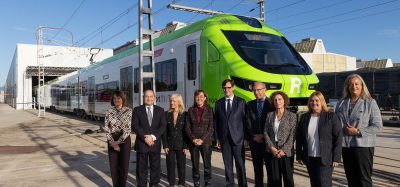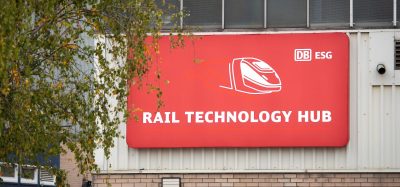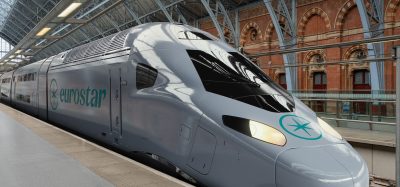SJ is back on track
Posted: 26 September 2007 | | No comments yet
From the threat of bankruptcy to the position of a profitable travel company in just a few years, SJ is now crowning themselves as the most efficient and profitable train company in Europe. But with Sweden’s old rail infrastructure still in use means that SJ is struggling to keep up with the European standard of high-speed trains. Nevertheless, the increase of passenger numbers shows that the Swedish people have made a conscious choice for the environment. In an interview for the Global Railway Review Claes Broström, Vice President of Fleet Management at SJ explains past, present and future investments.
From the threat of bankruptcy to the position of a profitable travel company in just a few years, SJ is now crowning themselves as the most efficient and profitable train company in Europe. But with Sweden’s old rail infrastructure still in use means that SJ is struggling to keep up with the European standard of high-speed trains. Nevertheless, the increase of passenger numbers shows that the Swedish people have made a conscious choice for the environment. In an interview for the Global Railway Review Claes Broström, Vice President of Fleet Management at SJ explains past, present and future investments.
From the threat of bankruptcy to the position of a profitable travel company in just a few years, SJ is now crowning themselves as the most efficient and profitable train company in Europe. But with Sweden’s old rail infrastructure still in use means that SJ is struggling to keep up with the European standard of high-speed trains. Nevertheless, the increase of passenger numbers shows that the Swedish people have made a conscious choice for the environment. In an interview for the Global Railway Review Claes Broström, Vice President of Fleet Management at SJ explains past, present and future investments.
Only a few years ago, SJ was in a deep financial crisis. Since then, the government owned passenger train operator, a former Government enterprise agency, has managed to turn around the results with the aid of hard cutbacks and a comprehensive change in its programme. Today, an average of 100,000 journeys are made with SJ every day from 200 locations nationwide, and SJ has 90% of the market for train journeys exceeding 100 kilometres.
The rolling stock
The X 2000 is the brand name of Sweden’s tilting 200 km/h high-speed train class X2. They were launched in 1990 as a first-class only train, but since 1995, the trains also hold second class carriages. Even though the top speed of 200 km/h (120 mph) is unremarkable internationally, the X 2000-trains stand out because of the fact that most of the railway that the train travels upon was built in the late 1800s.
During 2006 and 2007, all of the X 2000-trains have been completely renovated and upgraded, both on the technical side and interior wise. The entire interior has been refurbished and a new design of the exterior of the train has been introduced.
“The work was finished this summer at a cost of approximately €50 million”, says Mr. Broström. “The only X 2000-trains left to be renovated are the seven X 2000/linx-trains that, until only a year ago, used to operate the Stockholm-Oslo line. They are scheduled to be finished next summer, adding another €10 million”.
The newest addition to the SJ train fleet are the X 40-trains, more commonly known as ‘the double-decker’. With its wide doors and low boarding threshold set at the same height as the platform, the X 40-trains makes it easy for all passengers, including those in wheelchairs, to embark and disembark quickly. Unfortunately, the X 40 have caused some trouble ever since it was introduced to passengers, and today only 21 of the 43 trains that SJ bought, at an investment of approximately €300 million, are in full operation.
“This is the way it works. All trains had a lot of faults on delivery, and you usually expect it to take three years before they run perfectly. But all the X 40-trains are supposed to be ready-to-use by this time next year”, explains Mr. Broström.
With its large capacity, the double-decker train is used primarily as a commuter train in the extended capital region of Sweden, ‘the Lake Mälaren Valley’, from which many people commute to Stockholm.
In Sweden, much like most countries in Europe, SJ operates a large number of InterCity-trains. InterCity (commonly abbreviated as IC on timetables and tickets) is the classification applied to certain long-distance passenger train services in Europe, and the term originated in the United Kingdom, with the InterCity sector of British Rail. Today, train set combinations of 107 engines and 450 passenger carriages are adjusted to demand on each line. In Sweden these trains are commonly known as a more simple train that operates long distances, but it was not always so.
To be called an InterCity-train in the 1980s the train had to live up to a certain, higher, standard. They were meant to be SJs most modern trains, and always included a bistro carriage with an InterCity-shop that carried perfume and such likes. When the X 2000-trains were introduced in Sweden, the InterCity-trains were instantly degraded.
And today they are the lowest on the rank?
“Well, yes, but they are about to regain some of their old status”, explains Mr. Broström. “A complete restoration of these trains is scheduled to start next year. The exterior will be painted black with a silver SJ logo, and the inside will show a cool Nordic design in grey and white with many original wooden details, just like the X 2000. And of course they will all offer Internet connection to all passengers”.
It sounds like major work on such old trains?
“It is an investment of approximately €60 million. We are simply taking all of the trains apart, down to their bare bones, and then refurbishing them with all new materials. The InterCity-trains are of course also at all times controlled and updated technically, but on the whole, they have not caused us many problems”, says Mr. Broström.
Outstanding efficiency and service
SJ has always been on the frontier when it comes to technical developments. For example, they made it possible to book and buy tickets off the Internet in 1997 and earlier this year they introduced ‘movies on board’, and they continue to strive to be a modern company, offering modern services, both on and off their trains.
“We put a lot of effort into on board services and after listening to our customers, we can offer better services than most of the European train companies. On the city-to-city trains the bookings are up to 80% in total and we have a couple of new projects that will help us fill the rest of the seats. I would say that SJ is one of the most efficient and profitable train companies in Europe”, says Mr. Broström.
By far the most appreciated service that SJ offers is on-board Internet. This service has been in use on the X 2000 and the X 40-trains for many years now, and it will be installed on all of the InterCity-trains as they go through their restoration next year.
“The request for Internet on board our trains is enormous”, explains Mr. Broström. “Ever since we introduced the service on the X 2000-trains we have had a steady increase in demand from our passengers. As a result we are continuously working with upgrading our wireless network and increasing the capacity of the Internet connection”.
Increase of passengers calls for future investments
Because of the rise in passenger numbers, SJ is running all of their rolling stock at full capacity. In order to do this efficiently, they are forced to optimise the performance of the trains, which has led to a large rationalisation of the whole maintenance and logistics process. Nothing unique about that, but SJ is also working hard to be as pro-active as possible.
Mr. Broström says, “We are really trying hard to work in a pro-active manner concerning our rolling stock, with an aim to prevent problems before they happen, which is not so common within our sector. And since we have been so successful in this effort, and with rationalising the maintenance, we are making it possible to maximise the use of our rolling stock”.
But this alone is not enough. To meet the increasing number of passengers, SJ plans to acquire a number of X 2000 light-trains in 2008-2009. The new trains will operate just like the X 2000-train, city to city.
What is the difference between the X 2000 currently in use and the new ‘light’ version?
“The difference between the new X 2000 light-trains and the normal X 2000 is that the new trains are more of a standard product, and this is simply because we need to shorten the time of delivery, “explains Mr. Broström. “We need the trains quite soon and they will have a top speed of around 200 km/h, just like the normal X 2000”.
The new X 2000 light-trains will help SJ meet the increasing numbers of passengers, for now, but they are at the same time looking into a more long term solution with a new generation of city to city trains, the replacement for the X 2000-trains. Logically these trains are called X 3000, and they are expected to be in traffic by 2012-2015.
“We are looking into what it is we need and what different constructors can offer us, so the project is still at a very early stage”, comments Mr. Broström.
For SJ, one of the biggest challenges it faces is concerning its rails. SJ would want to go faster with the new trains; at least increase the speed to 300 km/h. But that’s impossible with the rail infrastructure in Sweden today.
“We would want to be able to go as fast as many of the European trains – around 300-350 km/h”, expresses Mr. Broström. “With that speed you could travel across Sweden from Stockholm to Gothenburg in two hours or from Stockholm to Malmö in the south in three hours.
What is needed for that to become a reality?
“We would need new and straighter rails”, explains Mr. Broström. We also need to increase the capacity on the existing rails. In this aspect Sweden is far behind the rest of Western Europe”.
Proud to be environmentally friendly
To say that SJ takes the environmental issues serious is an understatement. SJ works on a daily basis with decreasing the impact on the environment. In 1994, SJ became the first company in transportation that was awarded the ecolabel ‘Bra miljöval’, the ecolabel with the hardest criteria in the world.
Within SJ, everything is checked for environmental impact, from the coffee mugs at the head office to the recycling of old carriages. There is also an environmental network within SJ which spreads information and exchanges experiences.
“The network consists of key people within each unit who are responsible for ensuring our environmental policy is followed”, explains Mr. Broström. “An environmental auditor regularly reviews the internal work and also checks that suppliers live up to SJs environmental demands. Every year, an environmental study is performed to find out which areas can be further improved and should be targeted”.
Why is it so important for SJ to work with the environmental issues?
“First of all, we genuinely care about the environment, but it’s also about listening to our passengers. When we asked our passengers in a survey earlier this year why they take the train, 36% answered that they chose to take the train because it is the best choice for the environment”, says Mr. Broström.
Almost all of the trains in Sweden are electricity-driven. And SJ only buys renewable energy for its trains. This means that the production of electricity for the trains only causes a minimum amount of emissions. Calculated per person for example the emission of carbon dioxide during a trip between Stockholm and Gothenburg is the equivalent of 3 millilitres of petrol.
“But our environmental program also covers recycling of everything on board the trains, the choice of materials and colours, and minimising the necessary use of chemicals for maintenance and cleaning of the carriages”, explains Mr. Broström. “We have also introduced a system for ticket free travels. Nothing is forgotten”.
Aims for the future
In Sweden, SJ has started to co-operate with travel agencies, offering unique chartered trains to events in Sweden, but also to events in southern Europe. SJ believes that in the future, the train will be able to compete with the low fare airlines when it comes to travels within Europe.
“It’s a more comfortable way of travelling and by far the best choice for the environment”, says Mr. Broström.
What are SJ’s main aims for the future?
“We strive to be more efficient and to offer our passengers better services”, explains Mr. Broström. “We want to make train travel cheaper, safer and even more environmentally friendly, and of course, to continue to be a profitable company with a good revenue”.
About the author
Mr. Claes Broström has been employed with SJ since 2006. Before joining the company, Mr. Broström has held a number of positions at various companies including Volvo, Ericsson and Nokia. Mr. Broström is currently Vice President of Fleet Management at SJ.
Global Railway Review Autumn/ Winter Issue 2025
Welcome to 2025’s Autumn/ Winter issue of Global Railway Review!
The dynamism of our sector has never been more apparent, driven by technological leaps, evolving societal demands, and an urgent global imperative for sustainable solutions.
>>> Read the issue in full now! <<<







